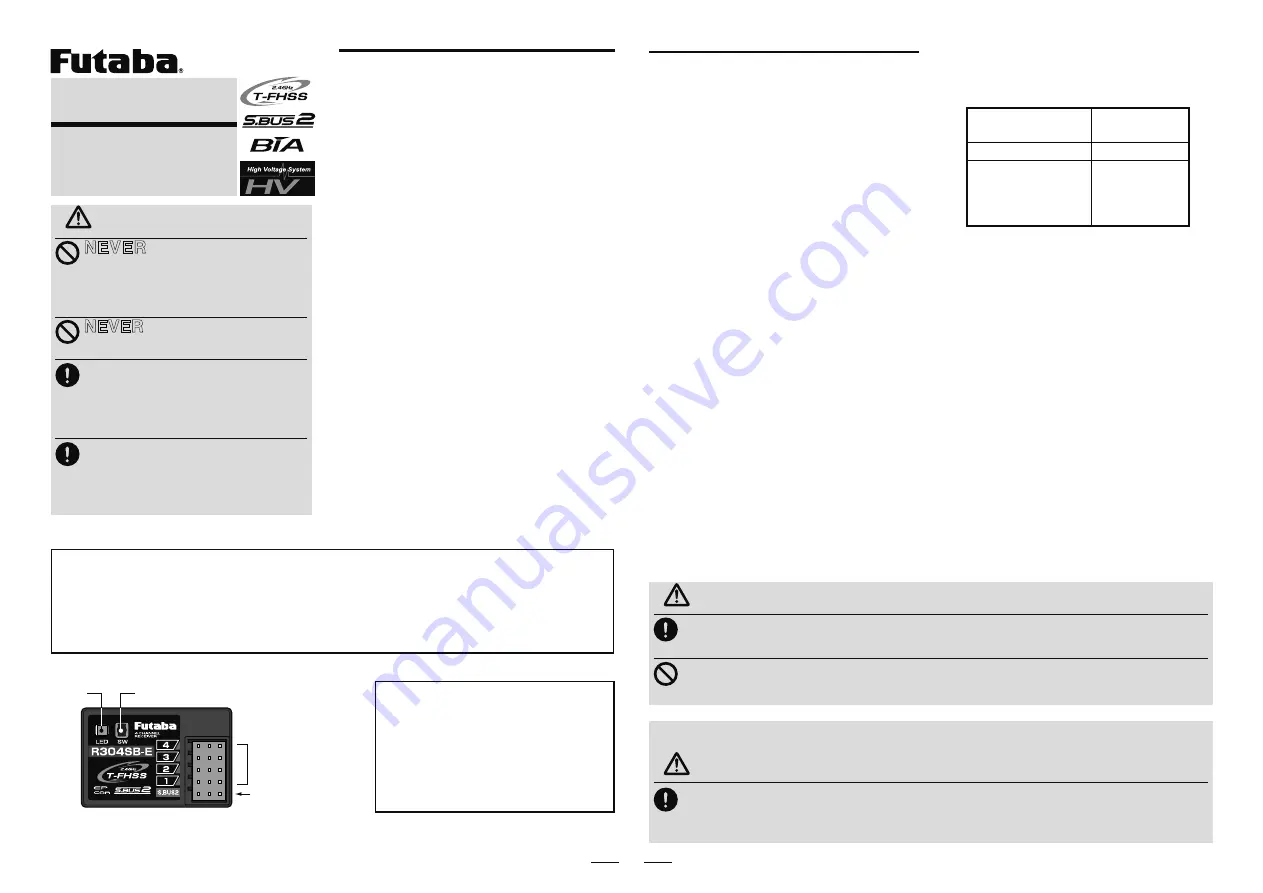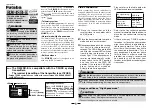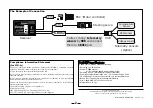
Link Procedure
Each transmitter has an individually
assigned, unique ID code. In order to start
operation, the receiver must be linked
with the ID code of the transmitter with
which it is being paired. Once the link is
made, the ID code is stored in the receiver
and no further linking is necessary unless
the receiver is to be used with another
transmitter.
1
P l a c e t h e t r a n s m i t t e r a n d t h e
receiver close to each other within
half (0.5) meter.
2
Place the transmitter into the linking
mode, and turn on the receiver.
3
During countdown, push the receiver
tact switch for approximately 2
seconds. The LED will begin to blink
red. After the receiver LED switches
from blinking red to green
→
red
steady light, If the transmitter and
receiver are linked normally, set the
power switch to the OFF position
a n d t h e n t u r n o n t h e P W R O N
position. If the receiver LED lights
gr e e n , l i n k i n g wa s s u c c e e d e d .
Actually check servo operation.
* Please refer to the table below for
LED status and receiver condition.
* Refer to the transmitters operation
manual for complete details on how to
place the transmitter into the linking
mode.
* If there are many T-FHSS systems
turned on in close area, your receiver
might have difficult in establishing a
link to your transmitter. This is a rare
occurrence. Your receiver may link to
the undesirable transmitter. This is
very dangerous if you do not notice
this situation. In order to avoid the
problem,we strongly recommend
yo u d o u bl e c h e ck w h e t h e r yo u r
receiver is really under control by your
transmitter.
WARNING
After the linking is done, please cycle receiver power and check if the receiver
to be linked is really under the control by the transmitter to be linked.
Do not perform the linking procedure with motor's main wire connected or
with the engine operating as it may result in serious injury.
Link switch
LED
S.BUS2 / (Battery)
CH output
(1 to 4) / (Battery)
Operating Precautions:
Once the
R304SB-E
detects the
T-FHSS
normal mode
or
T-FHSS high
speed mode
, the detected mode is
locked as long as the power is ON.
When need to change the mode,
please cycle power.
Note:
The R304SB-E is compatible with the T-FHSS system
transmitters.
The receiver type setting of the transmitter is set T-FHSS.
*Futaba T-FHSS system does not work with current Futaba S-FHSS/FHSS/FASST-
est/FASST system.
Usage condition on "High Speed mode"
CAUTION
When using the high-speed mode, use a Futaba digital servo (including
brushless servo). Analog servos cannot be used.
• The use of analog servos may cause servo trouble.
1M23N28504
T-FHSS-2.4GHz System
S.BUS2, 4-Channel
Built-in Antenna Receiver
for EP Car Models
Thank you for purchasing the
R304SB-E
receiver. The
R304SB-E
is designed for use
with the Futaba
T-FHSS
system transmitter.
The
R304SB-E
receiver has adopted the newly
developed bidirectional communication
system "
T-FHSS
".
•Telemetry system
With the
telemetry system
, the running
status can be displayed at the transmitter.
The telemetry data can be checked at the
transmitter by connecting the
telemetry sensor
sold separately to the
S.BUS2
connector of the
R304SB-E
receiver.
•Normal mode/High Speed mode
The "Normal mode" accepts any type of servos
or the peripheral. The "High Speed mode"
only accepts the digital servos, including BLS
series, and most peripheral equipments such
as the brushless ESCs. Please pay special
attention to the information contained within
this manual and transmitter's manual in order
to have a pleasant running experience.
•Built-in antenna
The
R304SB-E
receiver is designed to be
used only for EP Car models.
R304SB-E
WARNING
NEVER
use dry batteries for
the power supply of the
R304SB-E
as this may cause difficulties with
the receiver's operation.
NEVER
use the
R304SB-E
in GP
(Engine) cars.
W r a p t h e r e c e i v e r w i t h
something soft,such as foam
rubber,to avoid vibration. Do not
splash water over the receiver.
Since the receiver generates a
certain amount of heat, install
the place with good ventilation.
No signal recep-
tion
LED: Red
Receiving signals
LED: Green
Unrecover-
able failure
(EEPROM,etc.)
LED: Red
and Green
turn on alter-
nately
1




















